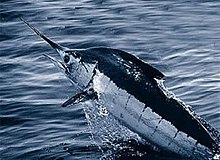Marlin
| Marlin Temporal range:
| |
|---|---|

| |
| Atlantic blue marlin(Makaira nigricans) | |
| Scientific classification | |
| Domain: | Eukaryota |
| Kingdom: | Animalia |
| Phylum: | Chordata |
| Class: | Actinopterygii |
| Order: | Istiophoriformes |
| Family: | Istiophoridae Rafinesque,1810 |
| Type genus | |
| Istiophorus Lacépède,1801
| |
| Genera | |
Marlinsare fish from the familyIstiophoridae,which includes 11 species.
Name[edit]
The family'scommon nameis thought to derive from their resemblance to a sailor'smarlinspike.[1]
Taxonomy[edit]
The family name Istiophoridae comes from the genusIstiophoruswhich first placed the speciesIstiophorus platypterusbyGeorge Kearsley Shawin 1792 from the Greek wordἱστίονistionmeaning "sail"that describes the shape of the species's dorsal fins.[2]: 6
Family description[edit]
Marlins have elongated bodies, aspear-likesnoutor bill, and a long, rigiddorsal finwhich extends forward to form acrest.
Marlins are among the fastest marine swimmers. However, greatly exaggerated speeds are often claimed in popular literature, based on unreliable or outdated reports.[3]
The larger species include theAtlantic blue marlin,Makaira nigricans,which can reach 5 m (16 ft) in length and 820 kg (1,810 lb) in weight[4]and theblack marlin,Istiompax indica,which can reach in excess of 5 m (16 ft) in length and 670 kg (1,480 lb) in weight. They are popularsporting fishin tropical areas. The Atlantic blue marlin and thewhite marlinare endangered due tooverfishing.[5]
Marlins can change colour, lighting up their stripes just before attacking prey.[6]
Classification[edit]
The marlins areIstiophoriformfish, most closely related to theswordfish(which itself is the sole member of the familyXiphiidae). Thecarangiformesare believed to be the second-closest clade to marlins. Although previously thought to be closely related toScombridae,genetic analysis only shows a slight relationship.
Extant genera[edit]
Istiophoriform genera and species Image Genus Living species Common name  black marlin
black marlinIstiompax
(Whitley, 1931)Istiompax indica black marlin  Atlantic sailfish
Atlantic sailfishIstiophorus
(Lacépède, 1801)I. albicans Atlantic sailfish I. platypterus Indo-Pacific sailfish  Atlantic blue
Atlantic blueMakaira
(Lacépède, 1802)Makaira nigricans
(Lacepède, 1802)Atlantic blue marlin Makaira mazara
(Jordan&Snyder,1901)Indo-Pacific blue marlin  white marlin
white marlinKajikia
(Hirasaka & H. Nakamura, 1947)Kajikia albida
(Poey,1860)white marlin Kajikia audax
(Philippi (Krumweide),1887)striped marlin  longbill
longbillTetrapturus
(Rafinesque, 1810)Tetrapturus angustirostris
(S. Tanaka (I),1915)shortbill spearfish Tetrapturus belone
(Rafinesque,1810)Mediterranean spearfish Tetrapturus georgii
(R.T. Lowe,1841)roundscale spearfish Tetrapturus pfluegeri
(C. R. Robins&de Sylva,1963)longbill spearfish
Fossil genera[edit]
Marlins have a continuous fossil record from the Miocene onwards, with the oldest uncontroversial fossil dated to 22 million years ago.[7]It is thought that they probably evolved in theParatethysSea.[8]
The following fossil genera are known:[9][10]
- †MorgulaGraciaet al., 2022
- †PizzikoskermaGracia, Villalobos-Segura, Ballen, Carnevale & Kriwet, 2024
- †PrototetrapturusGraciaet al., 2022
- †SicophasmaGracia, Villalobos-Segura, Ballen, Carnevale & Kriwet, 2024
- †SpathochoiraGraciaet al., 2022

Popular culture[edit]

In theNobel Prize-winning authorErnest Hemingway's1952 novelThe Old Man and the Sea,the central character of the work is an aged Cuban fisherman who, after 84 days without success on the water, heads out to sea to break his run of bad luck. On the 85th day, Santiago, the old fisherman, hooks a resolute marlin; what follows is a great struggle between man, sea creature, and the elements.
Frederick Forsyth's story "The Emperor", in the collectionNo Comebacks,tells of a bank manager named Murgatroyd, who catches a marlin and is acknowledged by the islanders ofMauritiusas a master fisherman.
A marlin features prominently in the last chapter and climactic scenes ofChristina Stead'sThe Man Who Loved Children.Sam's friend Saul gives Sam a marlin, and Sam makes his children help him render the fish's fat.
TheMiami Marlins,a professional baseball team based in Miami, Florida, is named after the fish.
See also[edit]
References[edit]
- ^Harper, Douglas (November 2001)."marlin".Online Etymological Dictionary.
- ^Scharpf, Christopher (13 September 2023)."Order CARANGIFORMES".The ETYFish Project.p. 1–19.Retrieved18 December2023.
- ^Svendsen, Morten B.S.; Domenici, Paolo; Marras, Stefano; Krause, Jens; Boswell, Kevin M.; Rodriguez-Pinto, Ivan; et al. (2016-10-15)."Maximum swimming speeds of sailfish and three other large marine predatory fish species based on muscle contraction time and stride length: a myth revisited".Biology Open.5(10): 1415–1419.doi:10.1242/bio.019919.ISSN2046-6390.PMC5087677.PMID27543056.
- ^"Makaira nigricans,blue marlin ".fisheries, gamefish.FishBase.
- ^"Tunas and marlins officially classified as threatened".Smithsonian Ocean.Smithsonian Institution– via ocean.si.edu.
- ^Pinkstone, Joe (26 February 2024)."Marlin use their surprising superpower to attack other fish".The Telegraph.Retrieved9 March2024.
- ^De Gracia, C.; Berning, B.; Kriwet, J. (March 2023)."The origin of modern marlins (Teleostei: Istiophoridae): new fossil evidence from the Lower Miocene of Austria".Journal of Vertebrate Paleontology.43(2): e2281490.doi:10.1080/02724634.2023.2281490.
- ^Fierstine, H.L. (2006)."Fossil history of billfishes (Xiphioidei)".Bulletin of Marine Science.79(3): 433–453.Retrieved30 April2024.
- ^De Gracia, Carlos; Correa-Metrio, Alex; Carvalho, Mónica; Velez-Juarbe, Jorge; Přikryl, Tomáš; Jaramillo, Carlos; Kriwet, Jürgen (2022-12-31)."Towards a unifying systematic scheme of fossil and living billfishes (Teleostei, Istiophoridae)".Journal of Systematic Palaeontology.20(1): 1–36.doi:10.1080/14772019.2022.2091959.ISSN1477-2019.
- ^De Gracia, Carlos; Villalobos‐Segura, Eduardo; Ballen, Gustavo A.; Carnevale, Giorgio; Kriwet, Jürgen (2024)."Phylogenetic patterns in fossil and living billfishes (Istiophoriformes, Istiophoridae): evidence from the Central Mediterranean".Papers in Palaeontology.10(4).doi:10.1002/spp2.1559.ISSN2056-2799.
Further reading[edit]
- Sepkoski, Jack (2002)."A compendium of fossil marine animal genera".Bulletins of American Paleontology.364:560. Archived fromthe originalon 2011-07-23.Retrieved2011-05-19.
- Froese, Rainer, and Daniel Pauly, eds. (2005)."Istiophoridae"inFishBase.November 2005 version.
External links[edit]
- "Marlin fishing".FishingBooker(blog). 3 December 2015.
- Melissa Block & John Nielson (radio hosts), Jason Schratwieser (marlin sport fishing expert), Mahmoud Sivji (fish research biologist involved in discovery) (2 March 2007).'Ghost fish' revelation may alter marlin's status.NPR.org(radio news recording & transcript).All Things Considered.National Public Radio.Retrieved2023-10-29.— news clip discussing discovery that a look-alike fish has been widely mis-identified as white marlin

